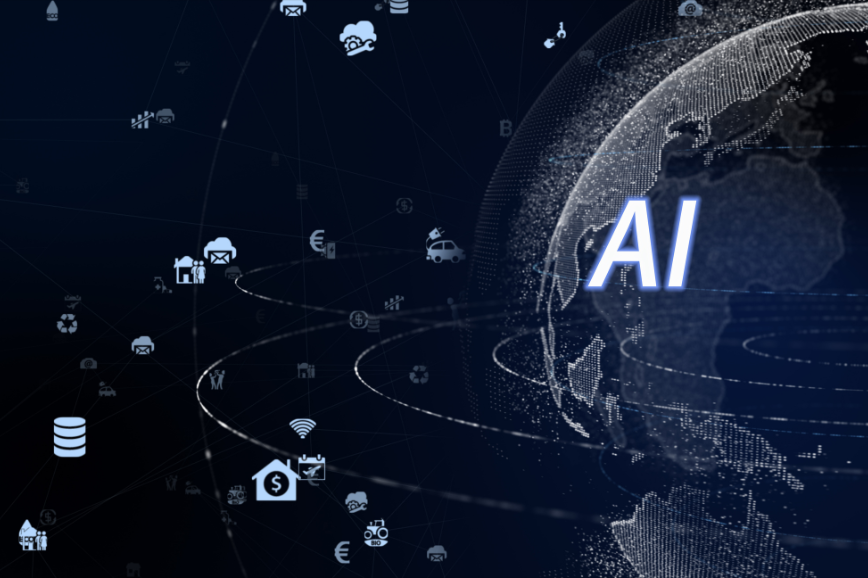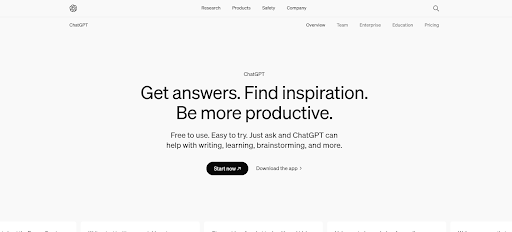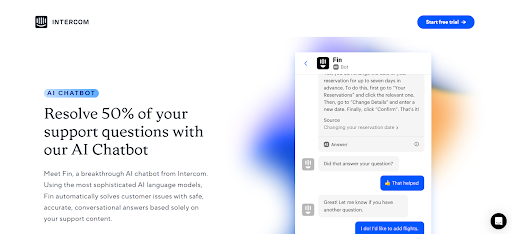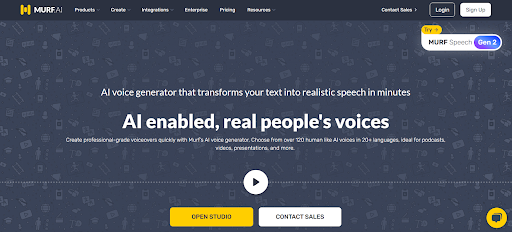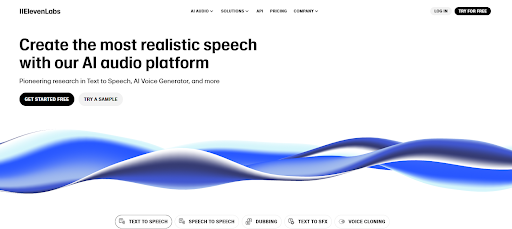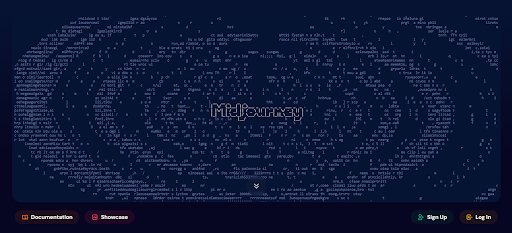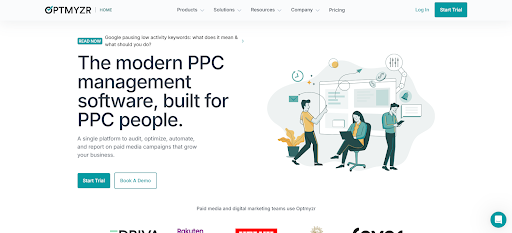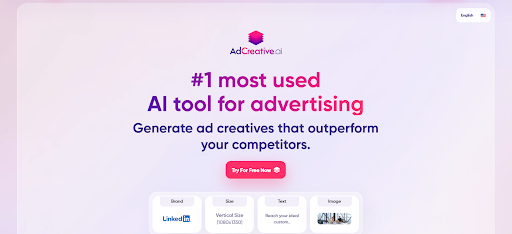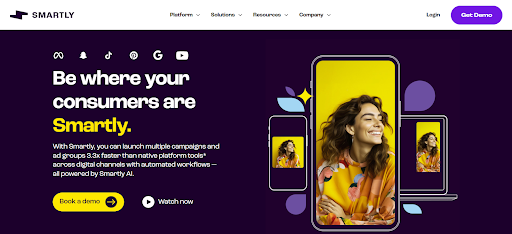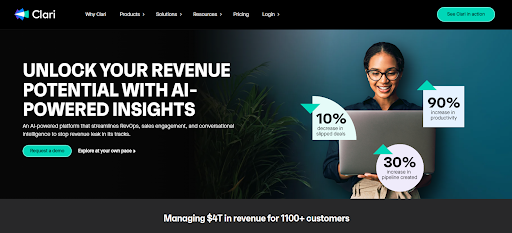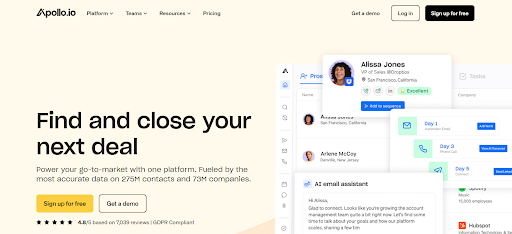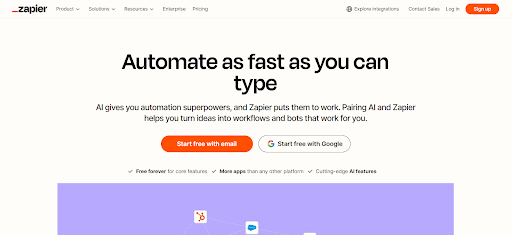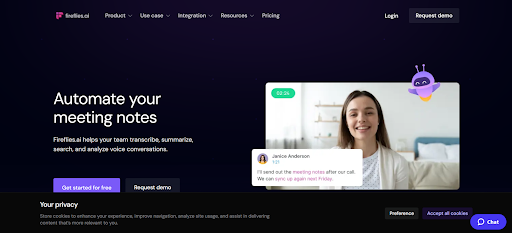Whether we like it or not, artificial intelligence (AI) is here to stay.
AI is revolutionizing industries and transforming how we interact with the world. From personalized recommendations on streaming platforms to advanced data analytics in business, AI is reshaping our experiences and capabilities.
Embracing these advancements is not just about keeping up with trends; it’s about leveraging powerful tools to drive innovation, efficiency, and growth in every aspect of our lives.
This blog explores the best AI tools of 2024, from chatbots to AI image generators and everything in between, to help you enhance productivity, creativity, and efficiency.
Keep reading to discover the best AI tools, or skip to…
Best AI Chatbots
A product of OpenAI, ChatGPT is an AI language model that generates human-like text responses based on the input it receives.
Key Features:
- Natural Language Understanding: ChatGPT can comprehend and respond to complex queries naturally and coherently.
- Adaptability: It is versatile and can used across various domains, including customer support, content creation, and more.
- Continuous Learning: The more you interact with it, the better it gets, making it a constantly improving tool.
Benefits:
ChatGPT’s adaptability and continuous learning make it a valuable asset for businesses looking to automate routine tasks and enhance customer interactions with a highly reliable and efficient AI assistant?.
Fin by Intercom is designed to streamline customer support operations by automating responses to common customer queries.
Key Features:
- Customer Support Automation: Handles up to 50% of incoming customer queries automatically.
- Contextual Understanding: Maintains the context of conversations for more natural and effective interactions.
- Seamless Integration: Integrates well with Intercom’s existing suite of tools, enhancing overall workflow efficiency.
Benefits:
Fin is a game-changer for customer support teams. It allows them to focus on more complex issues while ensuring customers receive quick and accurate responses to their common questions?.
Jasper Chat is designed to assist with various writing tasks, from drafting emails to creating social media posts.
Key Features:
- Content Creation Assistance: Helps generate various types of content quickly and efficiently.
- Search Engine Optimization: Offers keyword suggestions and optimization tips to ensure content ranks well on search engines.
- Tone and Style Adaptability: It can adapt its writing style to match your brand’s voice, ensuring consistency and personalization.
Benefits:
For marketing professionals, Jasper Chat is an essential tool. It not only speeds up the content creation process but also enhances the quality and effectiveness of marketing materials by ensuring they are optimized for search engines and aligned with brand guidelines?.
Best AI Voice Generators
Murf AI is a sophisticated AI voice generator that creates lifelike voices for various applications, such as podcasts, videos, and presentations.
Key Features:
- Extensive Voice Library: Over 120 voices in multiple languages to choose from.
- Voice Cloning: Ability to clone voices to create personalized content.
- Voice Emphasis Controls: You can fine-tune pitch, speed, and tone.
- Third-Party Integration: Works with tools like Google Slides, Canva, Adobe Audition, and more.
Benefits:
Murf AI stands out by producing studio-level voiceovers that ensure high-quality output. Its versatility makes it suitable for a wide range of content types, including educational and corporate materials.
LOVO AI specializes in AI-generated voices, offering tools for text-to-speech conversion, voice cloning, and content creation.
Key Features:
- Extensive Voice Library: Over 500 voices in 100+ languages.
- AI Script Writer: Generates scripts quickly using AI.
- Video Editor: Integrates voiceovers with video content seamlessly.
- Voice Cloning: Allows you to clone your own voice.
Benefits:
LOVO AI allows for extensive customization, enabling you to fine-tune voices by adjusting emotional tones, pronunciations, speed, and intonation. This versatility and user-friendly design significantly reduce the time required to produce high-quality audio and video content?.
ElevenLabs is an AI voice generation software that produces highly natural and fluent synthetic voices that can be used as voiceovers, audiobooks, virtual assistants, and more.
Key Features:
- Speech Synthesis: Converts text and audio into lifelike speech.
- VoiceLab: Allows creation and customization of unique voices.
- AI Dubbing: Translates and dubs existing videos.
Benefits:
Eleven Labs delivers high-quality, natural-sounding AI voices, making it ideal for various content types. Its accessible plans include advanced features like voice cloning without requiring high-tier subscriptions, offering great value.
Best AI Art and Image Generators
Midjourney is an AI-driven art generation tool designed for creative individuals and professionals. Simple text prompts enable you to produce images in many styles, from photorealistic to abstract.
Key Features:
- High-quality Settings: It offers various model versions, including specialized models for different art styles, such as Japanese Anime and Manga.
- Community-focused: Operates via Discord, fostering a vibrant community where users can share and discuss their creations.
- Adaptive Canvas: Can generate a wide range of styles and high-resolution images, making it highly adaptable to user needs.
Benefits:
Midjourney is ideal for creative individuals and professionals who want to explore diverse artistic styles and engage with a community of like-minded users. However, it requires a subscription, and its Discord-based interface may be a learning curve for some.
Canva’s Magic Studio suite leverages AI to simplify and enhance the creation of visuals.
Key Features:
- AI Photo Editor: Canva AI integration allows you to transform photos, erase clutter and background noise, and fine-tune your images at the touch of a button.
- User-friendly Interface: As part of Canva’s Magic Studio suite, the AI tool is designed to be intuitive and accessible, even for users with no prior design experience.
- Variety of Templates: It offers an extensive library of templates and design elements, empowering users to enhance their creativity and easily produce professional-quality visuals.
Benefits:
Canva is perfect for designers, content creators, and businesses requiring quick, high-quality visuals. Its user-friendly interface and powerful AI capabilities support many professional and creative applications, ensuring you can produce captivating assets with minimal effort. This tool is especially valuable for those looking to streamline their design process while maintaining high visual quality standards.
Optmyzr is a powerful tool designed to manage and optimize PPC campaigns.
Key Features:
- Bulk Editing: Allows for multiple changes across campaigns quickly.
- Account Management: Manage, edit, and view multiple Google Ads accounts simultaneously.
- Optimization Suggestions: Provides actionable recommendations to improve campaign performance.
- Integration: Works well with Google Sheets, Google Analytics, and other Google tools.
Benefits:
Optmyzr is highly user-friendly, making it perfect for beginners. It enhances efficiency by automating tasks and supporting bulk editing, significantly reducing manual work. The platform provides insightful analytics for fine-tuning campaign performance and is cost-effective, helping manage budgets efficiently by optimizing bids and other elements.
AdCreative.ai specializes in generating AI-driven ads and marketing materials quickly and efficiently.
Key Features:
- AI-Generated Ads: Creates professional-grade ads based on user inputs.
- Copy and Caption Generation: Produces compelling ad copy and captions.
- Performance Tracking: Monitors how audiences engage with ads and optimize future ads using machine learning.
- Versatile Formats: Supports the creation of images, banners, and videos.
Benefits:
AdCreative.ai saves you valuable time with its rapid ad creation process. It leverages data and machine learning to continuously improve ad performance. Additionally, it supports multi-platform ad creation, ensuring a wide reach across various advertising channels.
Smartly.io is a platform that automates the creation and management of advertising campaigns. It is highly regarded for its ability to handle large-scale ad operations for big brands.
Key Features:
- Ad Creation: Facilitates the creation of image and video ads using numerous templates.
- Campaign Management: Allows for the simultaneous management of multiple campaigns.
- Analytics and Reporting: Provides detailed data and reports on ad performance.
- Brand Compliance: Ensures ads adhere to brand guidelines and assets.
Benefits:
Smartly.io offers excellent scalability, making it ideal for large businesses with extensive advertising needs. It boosts efficiency by automating many aspects of ad production and campaign management. The platforms use data-driven insights to optimize advertising strategies, improving overall campaign effectiveness.
Gong.io is an AI-powered conversation analytics tool that analyzes sales calls, meetings, and emails to provide deep insights into sales interactions.
Key Features:
- Call Recording & Transcription: Automatically captures and transcribes sales calls for easy reference.
- Conversation Intelligence: Identifies key moments, talk ratios, and trends in sales conversations.
- Deal Risk Alerts: Notifies you when deals are in danger, allowing proactive intervention.
- Sales Coaching: Provides personalized feedback based on real-world data.
- Market Intelligence: Understands industry trends and competitor strategies.
Benefits:
Gong delivers enhanced insights into sales conversations, offering unparalleled visibility into sales interactions. By analyzing detailed conversations, it helps sales reps enhance their performance. Gong can also integrate seamlessly with popular CRM platforms, ensuring smooth workflow integration and data consistency.
Clari is a revenue operations platform that provides AI-powered insights for optimizing sales performance and improving revenue predictability.
Key Features:
- Automated Activity & Relationship Tracking: Eliminates manual data entry.
- Sales Process Visualization: Provides a panoramic view of the entire sales process.
- Real-Time Coaching: Delivers actionable insights and alerts in real time.
- Mutual Action Plans: Enhances collaboration between sales teams and buyers.
- Integration: Seamlessly integrates with CRM and other sales tools.
Benefits:
Clari provides accurate sales forecasts and predictive analytics, ensuring reliable planning. It can enhance pipeline management by identifying bottlenecks and facilitating smooth sales processes. Clari also promotes enhanced collaboration through mutual action plans and supports data-driven decisions with real-time insights, helping teams make informed choices effectively.
Apollo AI is a comprehensive sales engagement platform that combines lead generation, email tracking, and sales automation.
Key Features:
- Extensive Contacts Database: It has access to over 265 million contacts.
- Email Tracking:> Monitors email opens, click-through rates, and responses.
- Personalized Outreach: Uses AI to craft hyper-personalized emails.
- CRM Integration: Ensures reliable data coordination and teamwork.
- Automation: Simplifies outreach efforts and shortens sales cycles.
Benefits:
Apollo offers comprehensive tools for sales engagement, streamlining various aspects of the sales process. It easily integrates with existing CRM systems, ensuring smooth workflow integration. Plus, it simplifies and automates outreach efforts, improving efficiency and productivity.
Mem is an AI-powered note-taking app that organizes and connects your notes automatically.
Key Features:
- AI Tagging: Automatically tags and links notes.
- Powerful Search: Easily find and retrieve notes.
- Integration with Calendar: Syncs notes with your calendar for better organization.
Benefits:
Mem offers effortless organization, automatically keeping your notes well-structured without manual effort. It enhances accessibility by making it quick and easy to find and use your notes whenever needed.
Zapier is a workflow automation tool that connects different apps and automates tasks.
Key Features:
- Custom Workflows: Create automation workflows without coding.
- Wide Integration: Supports over 2,000 apps.
- Conditional Logic: Automate tasks based on specific triggers and conditions.
Benefits:
Zapier increases efficiency by reducing manual tasks and minimizing errors through automation. It is highly versatile, capable of automating a wide range of processes across various platforms, making it an invaluable tool for streamlining workflows.
Fireflies.ai is an AI tool that transcribes meetings and generates detailed notes.
Key Features:
- Real-Time Transcription: Transcribes calls and meetings in real time.
- Smart Summaries: Provides highlights, action items, and clickable timestamps.
- Versatile Sharing: Easily share transcripts via links or QR codes.
Benefits:
Fireflies improves meeting productivity by capturing important details without the need for manual note-taking. It facilitates collaboration through easy sharing and access to meeting notes, ensuring all team members stay informed and engaged.
Final Thoughts
The transformative impact of AI in 2024 is undeniable, revolutionizing productivity across various sectors. From sales and marketing to workflow automation and meeting efficiency, AI tools are enabling businesses to operate more effectively.
Take the first step towards a more efficient future by trying out these tools and experiencing their benefits firsthand.
And If you’re looking to elevate your brand’s digital presence further, consider partnering with GeistM. Our team of growth and content marketing experts is dedicated to driving results through data-driven insights.
Written By: Shannon Purcell-Miggan


